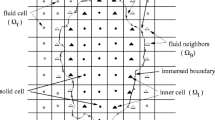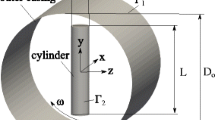Abstract
A two-dimensional flow solver using mixed grids has been developed for accurate and efficient simulation of steady and unsteady flow fields. The flow solver was cast to accommodate two different topologies of computational meshes: unstructured triangular meshes in the near-body region such that complex geometric configurations can be easily modeled, while unstructured adaptive Cartesian meshes are utilized in the off-body region to resolve the flow more accurately with less numerical dissipation by adopting a spatially high-order accurate scheme and solution-adaptive mesh refinement technique. The unstructured adaptive Cartesian meshes can be generated automatically and allow to handle data efficiently via quad-tree data structures. A chimera mesh approach has been employed to link the two flow regimes adopting each mesh topology. A second-order accurate vertex-centered scheme and a 3rd- or 5th-order accurate cellcentered WENO scheme has been utilized in the near-body region and in the off-body region, respectively. Validations were made for the unsteady inviscid vortex convection and the steady and unsteady turbulent flows over an NACA0012 airfoil, and the results were compared with other computational and experimental results.
Similar content being viewed by others
References
M. de Berg, Computational Geometry: Algorithms and Applications, 3rd ed., Springer, Chapter 5 (2007).
D. de Zeeuw, A Quadtree-Based Adaptively-Refined Cartesian-Grid Algorithm for Solution of the Euler Equations, PhD Thesis, University of Michigan (1993).
S. Jang and P. Morris, Multidimensional Interpolation for High Order Schemes in Adaptive Grids, KSCFE Journal, 11(4) (2006) 39–47.
M. Jung, O. Kwon, and H. Kang, Assessment of Rotor Hover Performance Using a Node-Based Flow Solver, KSAS International Journal, 8(2) (2007) 44–53.
A. Katz, A. Jameson, and A. Wissink, A Multi-solver Schemes for Viscous Flows Using Adaptive Cartesian Grids and Meshless Grid Communication, 47 th AIAA Aerospace Meeting proceeding, AIAA-2009-0768, USA (2009) 768–780.
S. Kamkar, A. Wissink, V. Sankaran, and A. Jameson, Feature-driven Cartesian Adaptive Mesh Refinement for Vortex-dominated Flows, Journal of computational physics, 230(16) (2011) 6271–6298.
X. Liu, S. Osher, and T. Chan, Weighted Essentially Nonoscillatory Schemes, Journal of computational physics, 115(1) (1994) 200–212.
D. Mavriplis, Unstructured Mesh Discretizations and Solvers for Computational Aerodynamics, AIAA Journal, 46(6) (2008) 1281–1298.
T. Pulliam, Euler and Thin-Layer Navier-Stokes Codes: ARC2D, and ARC3D, Computational Fluid Dynamics User Workshop (1984).
H. Saberi, M. Khoshlahjeh, R. Ormiston, and M. Rutkowski, Overview of RCAS and Application to Advanced Rotorcraft Problems, 4 th AHS Decennial Specialists’ Conference on Aeromechanics, San Francisco, USA (2004).
J. Sitaraman, A. Katz, S. Jayanarayanan, A. Wissink, and V. Sankaran, Evaluation of a Multi-Solver Paradigm for CFD using Overset Unstructured and Structured Adaptive Cartesian Grids, 46 th AIAA Aerospace Meeting proceeding, AIAA-2008-0660, USA (2008) 660–679.
J. Sitaraman, A. Wissink, and M. Potsdam, Parallel Unsteady Overset Mesh Methodology for a Multi-Solver Paradigm with Adaptive Cartesian Grids, AIAA Aerospace Meeting proceeding, AIAA-2008-7177, USA (2008).
S. Venkateswaran, S. Jayanarayanan, W. Andrew, D. Anubhav, J. Buvana, P. Mark, M. Dimitri, Y. Zhi, O. Daved, S. Hossein, C. Rui, H. Nathan, and S. Roger, Application of the Helios Computational Platform to Rotorcraft Flowfields, 48 th AIAA Aerospace Meeting proceeding, AIAA-2010-1230, USA (2010) 1230–1257.
A. Wissink, J. Sitaraman, D. Marvriplis, T. Pulliam, and V. Sankaran, A Python-Based Infrastructured for Overset CFD with Adaptive Cartesian Grids, 46 th AIAA Aerospace Meeting proceeding, AIAA-2008-0927, USA (2008) 927–944.
H. Yee, N. Sandham, and M. Djomehri, Low-Dissipative High-Order Shock-Capturing Methods Using Characteristic-Based Filters, Journal of computational physics, 150 (1999) 199–238.
Author information
Authors and Affiliations
Corresponding author
Additional information
Recommended by Associate Editor Dongshin Shin
Min Kyu Jung is a Ph.D student at the Computational Aerodynamics and Design Optimization Laboratory in the department of aerospace engineering, KAIST, Korea. His research interests are in computational simulations based on Cartesian meshes, and high order schemes.
Oh Joon Kwon is a professor in the Department of Aerospace Engineering, KAIST, Korea. His research interests are in CFD based on an unstructured mesh technique, design optimization and rarefied gas dynamics.
Rights and permissions
About this article
Cite this article
Jung, M.K., Kwon, O.J. Development of a 2-D flow solver on unstructured and adaptive Cartesian meshes. J Mech Sci Technol 26, 3989–3997 (2012). https://doi.org/10.1007/s12206-012-0893-6
Received:
Revised:
Accepted:
Published:
Issue Date:
DOI: https://doi.org/10.1007/s12206-012-0893-6




